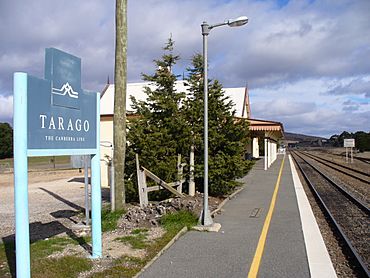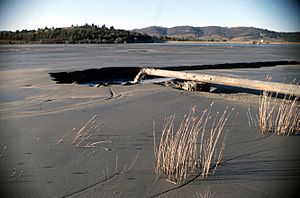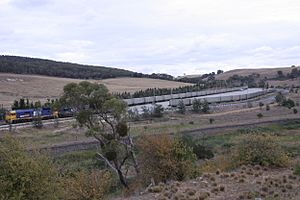Tarago, New South Wales facts for kids
Quick facts for kids TaragoNew South Wales |
|||||||||||||||
|---|---|---|---|---|---|---|---|---|---|---|---|---|---|---|---|

Tarago railway station in July 2007
|
|||||||||||||||
| Population | 510 (2021 census) | ||||||||||||||
| Established | 1827 | ||||||||||||||
| Postcode(s) | 2580 | ||||||||||||||
| Elevation | 703 m (2,306 ft) | ||||||||||||||
| Location |
|
||||||||||||||
| LGA(s) |
|
||||||||||||||
| Region | Southern Tablelands | ||||||||||||||
| County | Argyle | ||||||||||||||
| Parish | Mulwaree | ||||||||||||||
| State electorate(s) | Goulburn | ||||||||||||||
| Federal Division(s) | Hume | ||||||||||||||
|
|||||||||||||||
Tarago is a small town in the Southern Tablelands area of New South Wales, Australia. It is part of the Goulburn Mulwaree Council. Some of the area around Tarago, which includes lots of land for grazing animals, is on the eastern side of Lake George. This part is in the Queanbeyan–Palerang Regional Council area.
The town is about 39 kilometres south of Goulburn and 69 kilometres northeast of Canberra, Australia's capital city. You can find it on the road between Goulburn and Braidwood. Tarago is becoming known for its new projects that create clean, renewable energy.
Contents
History of Tarago
The land around Tarago traditionally belongs to the Ngunnawal people. Other Aboriginal groups also travelled through this area on their way to the coast or the Monaro region during the Bogong moth season. Very old stone tools, dating back 20,000 years, have been found near Lake George.
How Tarago Got Its Name
The town of Tarago was first called Sherwin's Flats. It later took the name "Tarago," which might be an Aboriginal word meaning "country." This name came from the town now known as Lake Bathurst, which is about 7 kilometres north of Tarago. The name changed when the railway line arrived and the train station opened on January 3, 1884.
Old Buildings in Tarago
Many historic buildings in Tarago are still used today. These include the original railway station from 1884, the St Josephs Catholic Church, and the Loaded Dog Hotel, which was built in 1848.
Heritage Sites
Tarago has several places that are important for their history. One of these is the Tarago railway station, which is officially listed as a heritage site.
Mining and Energy Projects
Tarago is close to the large Woodlawn Mine site. This area is now a hub for both mining and green energy projects.
Woodlawn Mine's Past and Future
The Woodlawn Mine operated from 1978 to 1998. Miners dug for valuable metals like gold, silver, copper, lead, and zinc. These metals were found in rock formations called the Lachlan Fold Belt. While the mine was active, special train tracks were added at Tarago's railway station. These tracks helped move minerals to and from the mine.
The mine closed when the company running it faced money problems. This caused issues because 160 miners did not receive their final pay. In 2012, a company called TriAusMin wanted to restart the mine. They planned to get more minerals from the three large tailings dams and the underground mine.
In July 2013, the New South Wales Government approved the project. This $126 million investment was expected to create up to 140 new jobs.
Woodlawn Bioreactor: Turning Waste into Energy
In the 1990s, a waste company called Collex (now Veolia) looked at the Woodlawn site as a place to handle Sydney's waste. They got approval to use the site in 2002. As part of their agreement, Collex promised to pay the former miners their missing wages.
The company planned to send six trains a week, each with 55 cars, from Sydney to the mine site. These trains would carry up to 400,000 tonnes of Sydney's waste each year. This was about 20% of all of Sydney's waste.
The project was very debated, especially because of the plan to ship waste by train. People in Sydney suburbs like Clyde and Auburn were worried about pollution. They tried to stop the project in court. The court agreed with them, saying the waste transfer station would cause air pollution.
However, the New South Wales Government, led by Bob Carr, overturned the court's decision. They passed a special law to allow the project. The government said Sydney needed a new waste site and that the miners needed their pay. The mine finally reopened on September 7, 2004. The miners received their pay soon after. A special station for transferring waste was built near Tarago, at Crisps Creek.
Today, the mine site is used for green energy projects while still handling Sydney's waste. Veolia, the owners, started using the mine in 2007 to collect methane gas. This gas is used to make electricity, which helps reduce greenhouse gas emissions. The company also plans to turn the broken-down organic waste into fertiliser.
In 2005, the government also approved Veolia building a large wind farm at the site. This $96 million project would have 25 wind turbines. It would create enough electricity to power 22,000 homes. However, the project was put on hold in 2006 because existing goals for reducing greenhouse gases were already being met.
Woodlawn Wind Farm
The Woodlawn Wind Farm is located about 4 kilometres southwest of Tarago. This facility has 23 wind turbines. It was built and is run by Infigen Energy. The wind farm started producing electricity in November 2011.
Transport in Tarago
Tarago railway station is a stop for six daily NSW TrainLink Xplorer train services. Three trains go towards Sydney and three go towards Canberra.
Tarago is located east of Lake George and north of Bungendore. It is a bit far from the main roads in the area, like the Federal Highway and Kings Highway. Because of this, train transport has always been very important for the town.
In October 2012, the New South Wales Government began a study to see if Main Road 92 could be extended. One idea was to improve rural roads from Nerriga west across the Shoalhaven River to Tarago, then south to the Kings Highway at Bungendore. Even though no firm plans have been made, the reopening of the Woodlawn mine has increased interest in this study. The mine operator prefers to use roads to move its products to coastal ports, which would mean many more heavy trucks on local roads.
Images for kids
-
Tarago, war memorial.






